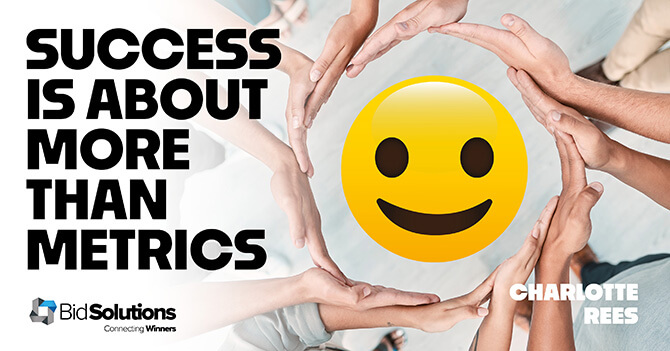
‘What does a successful bid and proposal team look like?’
There’s no doubt that adding the ‘bid and proposal’ terminology draws our minds straight to winning work. And yes, winning work is undeniably a core part of our success as bidding professionals.
But a successful team is about more than its outcomes. It’s about team happiness and health, the team feeling valued and integral to the business, and the team being invested in and rewarded.
It’s also no secret that happier teams can drive efficiency, productivity, generate new ideas and improve outputs within a business – which ultimately means winning more work!
So it’s about more than the metrics. I like to think there are three key components to measuring team success:

INPUT TO THE TEAM
A successful team starts with successful input and leadership. Senior members of a bid team are responsible for developing a great team and leading them to success. The leaders of the business are also responsible for supporting, positioning and investing in their bid team. What does success look like?
- A diverse team: with a mixture of backgrounds, insights, experience and personalities
- Clear strategy and direction: the team knows where they are heading, and how they (as a team) plan to get there
- Defined roles and responsibilities: everyone knows who does what, and the team has a clear management structure with support and routes to escalation
- Architecture and process: the team is given tools and processes that support them to operate in the most efficient way
- Investment: the bid team is given time (and money) to undertake personal development and learn new skills
- Reward and remuneration: the team is paid fairly and is effectively rewarded for the work they do

THE TEAM
For me, a healthy, happy team underpins success. I believe that putting people first is at the heart of any successful team. So what does this look like?
- Purpose: the team feels they have a purpose as individuals within the bid team, and within the wider business as a bidding function
- Health and wellbeing: the team’s physical and mental health is a priority – the team is protected from burnout, and transparent conversations and discussions around health adjustments and mental health are encouraged
- Communication and support: the team communicates well and is transparent. They can depend on other members in the team, and on the team leadership. In times of stress or uncertainty, everyone feels fully supported
- Resilient: the team overcomes challenges, adapts to change, and learns from setbacks
- Motivated: it’s evident the team has a positive attitude and an ambition to learn, develop and succeed
- Safety: the team feels physically and psychologically safe. They feel secure in their roles and feel safe to be vulnerable, speak out and share their opinions within the team, and the business.

TEAM OUTPUT
In bidding, we know our role, and our team’s role, is to win work. So it makes sense to measure part of our success through work winning metrics. These metrics could include:
- Team/individual win rates or value/fees won
- Achieving defined goals such as X number of bids in a year
- Assisting with sales targets
- Growth year on year
- Winning awards
Successful bid team output can also be about:
- Quality of bids: we strive for our bids to be competitive, with high quality content and solutions that meet clients’ needs
- Organisational positioning: the bid team should be seen as trusted strategic advisors and be given the opportunity, as a core part of the sales cycle, to influence the overall business strategy and its approach to winning work
What does this all mean and what can you do?
There are many different ways to measure a bid team’s success but a crucial part of that is the happiness and healthiness of the team itself. The metrics are important, but if your team is happy, enjoy being part of the bid team, and enjoy working within the organisation, then this is a success that shouldn’t be ignored!
To better understand the success and performance of your bid team, there are four simple actions you can take:
- Feedback: undertake a full review of the bid team’s people, leadership, outputs and impact on the wider business. Use 360o feedback and data analysis to get a true reflection of the team’s current position. You may want to start with some of the key topics mentioned above.
- Evaluate: review your feedback – what are the key trends, what are you doing well and what could be having a detrimental impact on your team’s success?
- Prioritise: taking your evaluations list, categorise your areas of improvement into must haves, nice to haves, and value added items. This will enable you to develop the most effective performance improvement plan.
- Target: define your actions and timescales from your prioritised list. Use SMART objectives wherever possible to assist with tracking progress and reviews
This approach isn’t linear, it’s a cycle allowing you to continue to gain feedback and ensure continuous improvement within your bid team in the long run. And finally, continue to communicate – give your team a safe space to say what they think, and make time for discussions around continuous improvement.
This article was written by Charlotte Rees.
Charlotte has worked in the bidding profession for nearly a decade, starting her journey as a bid and proposals apprentice for an engineering company. She has worked across several industries including IT services, facilities management and construction, and is currently an Associate Director Bid Manager, working within professional services. In 2018, Charlotte founded the Wellbeing and Inclusion in Bids and Proposals (WIBAP) community to target gender inequality within the profession and provide a space to share experiences and overcome the challenges we all face on a regular basis.

